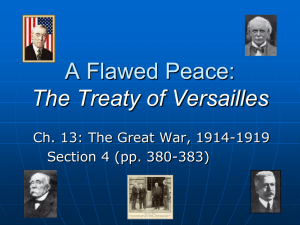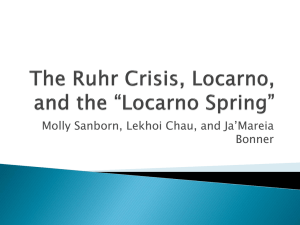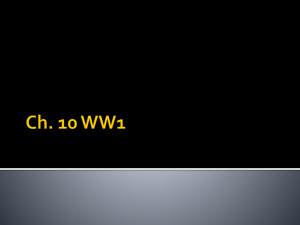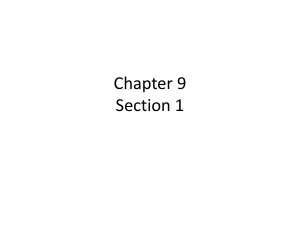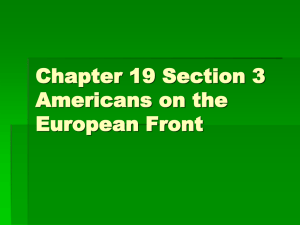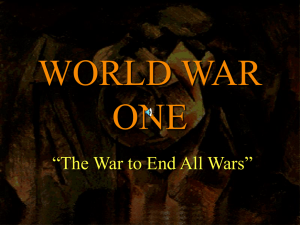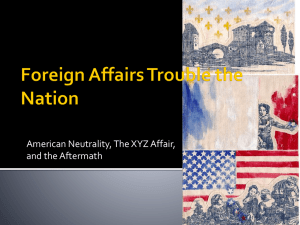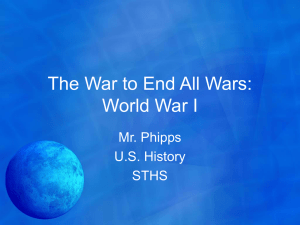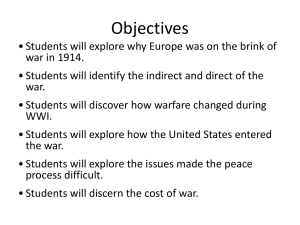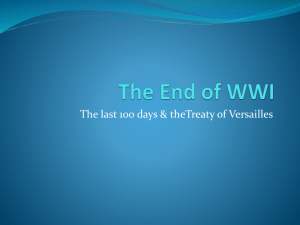File
advertisement
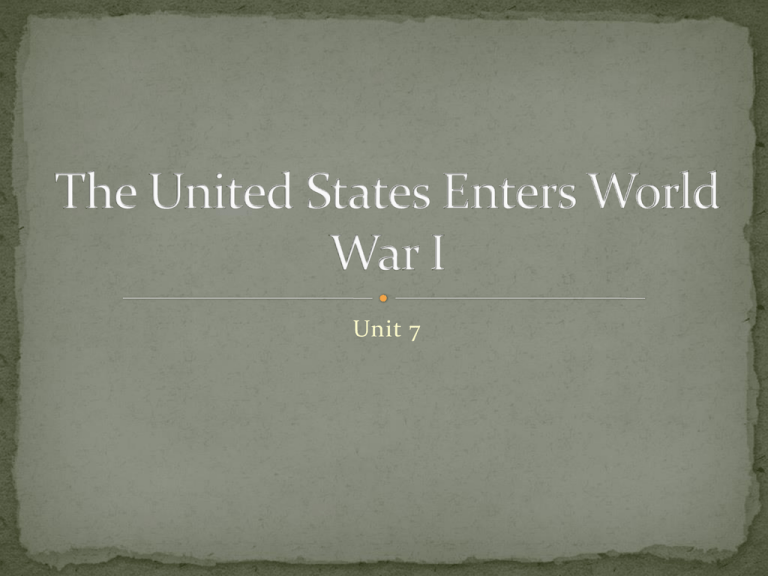
Unit 7 What political circumstances in Europe led to World War I What events motivated the United States to join the war? Nationalism Imperialism Militarism Propaganda Triple Alliance Triple Entente Militarism • • Strong buildup of armed forces ; Aggressive military preparedness Arms race between Britain and Germany Nationalism • • Feeling of strong pride, loyalty, and devotion to one’s nation Right of selfdeterminationthe idea that those who share a national identity should have their own country and government Imperialism • Economic and political control of a strong nation over weaker nations Alliance System • • Triple Alliance(Central Powers)Germany, Austria-Hungary, Italy (Switches sides) Triple Entente (Allies)- Britain, France, Russia Archduke of Austria-Hungary Franz Ferdinand was assassinated by Gavrilo Princip, a Bosnian rebel Serbian officials knew of plot Austria-Hungry wanted to crush Serbia to stop nationalism from threating empire Asked Germany for support Afraid Russia would start war if they attacked Serbia Austria-Hungary declared war on Serbia on July 28 Russia began mobilizing military Germany declared war on France and Russia World War I had begun Germany immediately attacked France Schlieffen Plan- Quick drive through Belgium, then France to capture Paris; Then attack Russia British government had a treaty with Belgium promising it would help Belgium stay neutral Britain declared war on Germany when German troops moved across Belgium Western front Stalemate- trench warfare • • • • Cultural /Economic Ties Unrestricted Submarine warfare Most Americans • supported the Allies cause British propaganda helped sway favor to allies • Many U.S. banks invested heavily to the Allies Allied win was necessary for the invested money to be paid back • Germany announced they would sink any ship in waters around Britain without warning The Lusitania, a British passenger liner carrying American civilians, was torpedoed and sunk by German submarine Germany promised to not sink merchant ships after warning from U.S. (Kept U.S. out of war past Election of 1916) Restarted on Feb. 1, 1917 Sunk 6 American ships • • Zimmerman Note • • • • • January 1917 Telegram sent from office of Arthur Zimmerman to the German ambassador to Mexico Promised to return Texas, New Mexico, and Arizona to Mexico if it allied with Germany Intercepted by British intelligence Printed in American newspapers April 2, 1917: President Wilson asks Congress for declaration of war on Germany Resolution was passed a few days later with overwhelming support Only 50 representatives and six senators voted against declaring war How did international alliances help create tensions in Europe? Why might some Americans have chosen to support either the Allies or the Central Powers? Why did the sinking of the Lusitania affect U.S. public opinion about the war? Why would Germany’s offer to Mexico worry many Americans? What did Congress do to prepare the economy for war? How did life change for women on the home front during World War I? Victory garden Espionage Draft/Conscription War Industries Board • • • • • Organized the creation of war materials Encouraged companies to use mass-production techniques to increase efficiency Urged them to eliminate waste by standardizing products Told factories what they could make Distributed raw materials, ordered new factories to be built, sometimes set prices (Caused retail prices to soar) Food Administration • • • • Run by Herbert Hoover Job to increase food production while decreasing food consumption Urged families to conserve food Encouraged families to plant and grow their own vegetables (Victory gardens) Fuel Administration • • • • Managed the use of coal and oil Started daylight savings time to save energy Urged people to have “Heatless Mondays” Made workweeks shorter for factories that were making goods not used for war National War Labor Board(1918) Tried to get companies to pay better wages, use 8 hour workday, allow unions the right to organize and bargain collective Labor leaders agreed not to disrupt war production Increased union participation by more than 1 million Women joined the workforce in record numbers Hired for jobs traditionally held by men More than 1 million women joined workforce Helped show women hold jobs that many believed only men could do Great Migration Huge movement of African Americans to the north (300,000- 500,000) Worked in factories War Financing • • • • • • U.S. spent about $35 billion on war effort Congress raised income rates New taxes on company profits War-profits tax Excise Taxes (tobacco, liquor, luxury goods) “Liberty Bonds”/ “Liberty Loans” (People lend the government money, and the government promised to repay the money with interest) Committee of Public Information • • • • • Headed by muckraker George Creel Job was to “sell” the war to the American people First national propaganda agency (Biased communication designed to influence people’s thoughts and actions) Gave jobs to advertising experts, artists, authors, songwriters, entertainers, public speakers, and motion picture companies Four-Minute Men- gave speeches urging audiences to support the war in various ways Espionage Act of 1917 Made it illegal to aid the enemy, give false reports, or disrupt the war effort Sedition Act of 1918 Made it illegal to speak against the war publicly Both laws were upheld in court Along with the CPI, helped lead to violence against many groups German Americans, labor activists, pacifists, socialists In 1917, the United States had roughly 200,000 troops in its army and National Guard Many more were needed Progressives were against forced military service, but believed a draft was needed Selective Service Act of 1917 Required all men between 21-30 to sign up Lottery randomly determined order on which men were called before a local draft board Draft board was responsible for selecting and releasing people for military service Consisted of people from local communities About 2.5 million were drafted African Americans • • • • 400,000 African Americans were drafted 42,o00 served overseas as combat troops Encountered discrimination as they had to serve in racially segregated units, usually under the supervision of white officers All African American 92nd and 93rd Infantry Divisions won praise from French commander Pepin and U.S. commander , John J. Pershing Women • • • • • First war in which women officially served in the armed forces Served in non-combat roles More than 11,000 women served in the navy. Enlisted at rank of yeoman (Office jobs, chemists, electricians, radio operators) Army did not enlist women, hired them as temporary workers to work in office jobs Army nurses serving in the Army Nursing Corps were the only women to be sent overseas 12,000 Native Americans 20,000 Puerto Ricans Thousands of Mexican Americans served Volunteered for service more than any other minority group in the U.S. Some Asians fought on the side of the United States Even before they were citizens Granted citizenship for their contributions Why do you think the federal government undertook such wide-scale economic and social mobilization? How did life change for women on the home front during World War I? How did life change for African Americans on the home front during World War I? How were Americans’ rights limited during World War I? How did new technologies increase the number of casualties compared to other wars? Why was the arrival of the U.S. forces so important to the war effort? Why did President Wilson’s ideas for peace negotiations differ from those of French Premier Clemenceau and British Prime Minister Lloyd George? Convoy Armistice National self-determination Reparations Resolve Trench warfare Trench Warfare • • • • • Network of trenches built across France all the way to the Belgian cost Caused a stalemate in the fighting on the Western Front Front line, support, reserve trenches “No Man’s Land” Rat infested, Trench foot, Trench mouth New Technology • • • • • • Artillery guns placed far behind the battle lines Machine guns Poison gas Armored tanks Zeppelins (Giant helium filled balloons) Airplanes Convoy System • • • • Devised by American admiral William Sims Convinced the British to use navy ships to guard passenger and merchant ships Greatly reduced the number of shipping losses incurred by the British Also, helped ensure U.S. troops arrived safely to Europe Russia Pulls Out of War • • • • • Russian Revolution began in March 1917 Vladimir Lenin’s Bolshevik Party took power in 1917 and established a Communist state Lenin pulled Russia out of the war to focus on building his Communist state Treaty of Brest-Litovsk- agreement between Russia and Germany. Russia gave up Ukraine, its Polish and Baltic territories, and Finland Allowed Germany to focus on 1 front Nearly 2 million U.S. troops were sent to Europe “Doughboys” Fresh and ready to fight John J. Pershing was commander of American Expeditionary Force By May 1918, Germany was within 40 miles of Paris Americans started first major attack Captured village of Cantigny June 1, U.S. and French troops stopped German drive at Chateau-Thierry Battle of Argonne Forest Began on Sept. 26, 1918 Biggest offensive for the American Expeditionary Forces U.S. troops slowly advanced By early November, U.S. troops had opened a hole on the eastern side of the German line German troops began falling back November 3, 1918- Austria-Hungary and Ottoman Empire surrendered to the Allies November 3, 1918- German sailors in Kiel rebelled Main base of German fleet Mutiny spread quickly as soldiers and workers seized power in other German towns November 9, 1918- socialist leaders in Berlin established a German republic November 11, 1918- Germany signed an armistice (an agreement to stop fighting) Casualties 22 million deaths (U.S.- 48,000(battle), 62,000 (disease)) 20 million wounded (U.S.- 200,000) 10 million refugees Costs $338 billion In January 1919, delegates from 27 countries met at Palace of Versailles Treaty of Versailles- Treaty with Germany Germany was not in attendance Treaty of Saint-Germain- Treaty with Austria-Hungary Meetings lasted 5 months “Big Four” President Woodrow Wilson (United States) Prime Minister David Lloyd George ( Great Britain) Premier Georges Clemenceau (France) Prime Minister Vittorio Orlando ( Italy) Russia was not invited to meetings Allied leaders did not recognize Lenin’s government Points 1-5 (Prevention of Future Wars) • • • • • No secret treaties (open diplomacy) Freedom of the seas Free trade (Lower or abolish tariffs) Disarmament (removing weapons to “lowest point consistent with domestic safety”) Fair changes to colonial changes Points 6-13 (National Self-determination) • • • Idea that the borders of • countries should be drawn based on ethnicity • and national identity Ethnic groups would form their own nation-states or • decide for themselves which nation they would belong to No nation should keep territory taken from another nation Point 14 Creation of the League of Nations International organization to address diplomatic crises Members would help keep peace by promising to respect and protect each other’s territory and political independence British Prime Minister Lloyd and French Premier Clemenceau wanted to punish Germany Wanted to prevent further invasions by Germany Britain did not want to give up its naval advantage Treaty of Versailles would ignore freedom of the seas, free trade and fair settlement of colonial claims No colonial people in Asia or Africa gained independence France and Britain took over colonial areas in Africa and Middle East Japan took over colonies in East Asia Provisions • • • • • • Established 9 new nations (Splitting up Austro-Hungarian, Russian, German, and Ottoman Empire) Greatly reduced Germany’s military Germany was blamed for causing the war (war-guilt clause) Germany was required to pay reparations- money to pay for the war damages caused ($33 million; Designed to keep Germany’s economy weak) Germany had to give back territory of Alsace-Lorraine to France Germany’s troops were not allowed west of the Rhine River (Rhineland; Demilitarized zone) Weaknesses • • • • • Harsh treatment of Germany weakened ability to provide a lasting peace War guilt clause humiliated Germany Germany was never going to be able to pay off the reparations bill, especially after being stripped of overseas colonies Russia was excluded from peace conference and lost more territory than Germany did Treaty ignored the rights of colonized people for self-determination (Especially in Southeast Asia) Most of the opposition in the United States to the Treaty of Versailles involved the League of Nations “Irreconcilables” Felt League was the type of organization the Founders warned about (Took power out of the hands of Congress) “Reservationists” Agreed to ratify treaty, only if language was changed to allow Congress the constitutional right to declare war Provision for joint economic and military action against aggresssion did not require Congressional approval Wilson refused to negotiate and campaigned heavily to the American people Senate voted on treaty 2 times (Nov. 1919 & Mar. 1920) Refused to approve treaty both times After Wilson left office in 1921, the U.S. negotiated separate peace treaties with each of the Central Powers League of Nations formed without the United States What could the Americans bring to the war to help the Allies? How did the postwar goals of the main Allies vary? How do you think the Treaty of Versailles affected Germany in the years following WWI? What were the Senate’s objections to the Treaty of Versailles?
